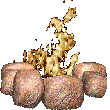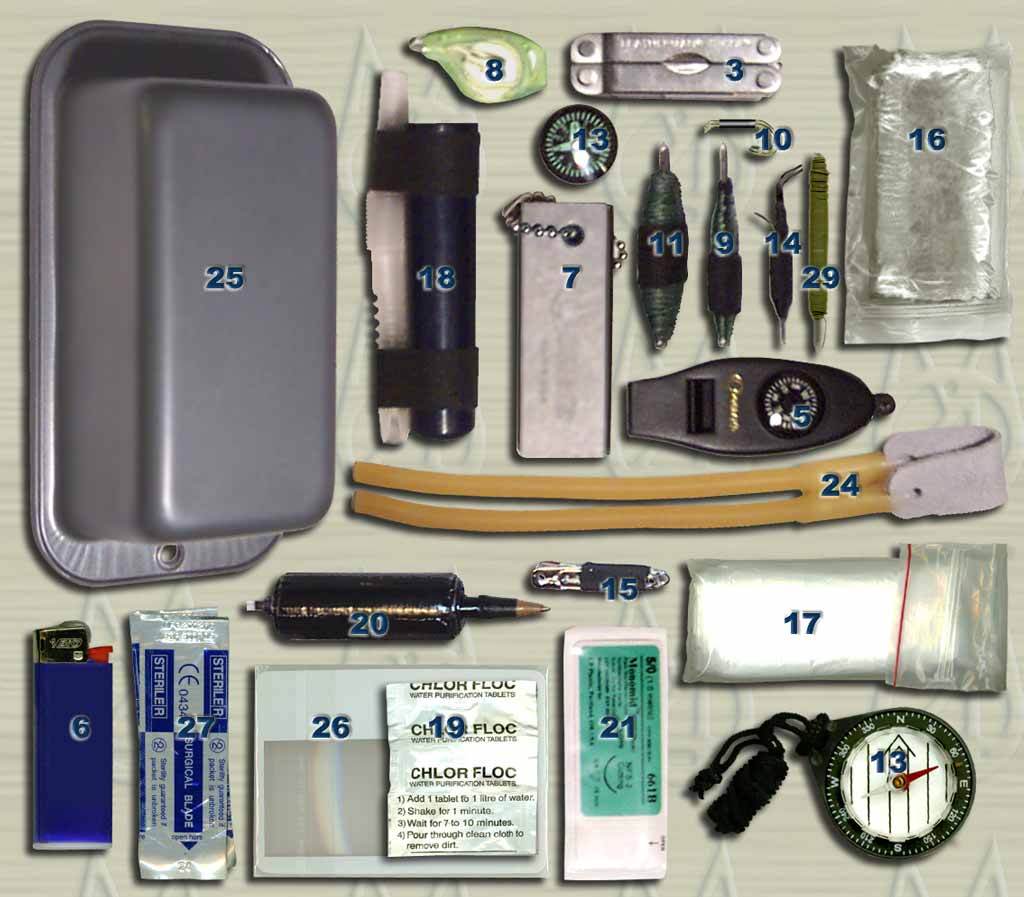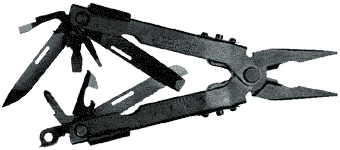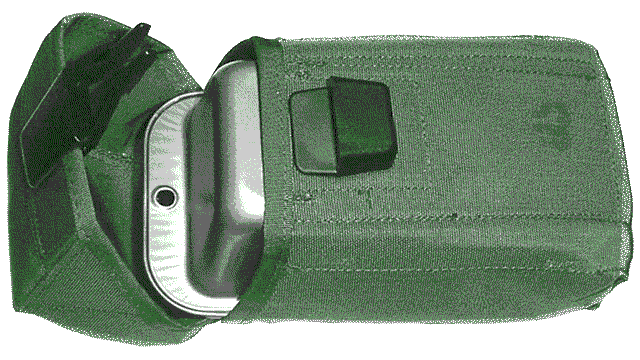 How to Build a decent Wilderness Survival Kit
How to Build a decent Wilderness Survival Kit How to Build a decent Wilderness Survival Kit
How to Build a decent Wilderness Survival KitAnother M40 Basement Project
A Wilderness Survival Kit is an absolute must if you spend any time away from civilization (hunting, fishing, camping, hiking, etc). There are commercial kits available out there for purchase, but building your own helps you to think about the what-ifs involved in living off the land, and also the opportunity to tailor the kit to your skill sets and tastes. I detail one of my relatively comprehensive kits below. I have listed each item and explained some of the various uses for each as well.
As a preparedness buff, I would also recommend having a Home Kit and a Car Kit.
A home kit is something every family should think about making. It could be a small closet that contains all emergency supplies (fire extinguishers, first aid kit, storm supplies, etc). Canned foods, some (stabilized) water, and maybe a 10 lb. sack of rice are a good start. Its also nice to keep some candles, flashlights and a radio there. A particularly nice thing to have is one of those hand-cranked radios. About 30 seconds of cranking will give you about 20-30 minutes of sound. I use one of these while camping. For a decent discussion on home preparedness and kits, see this page: http://mysite.verizon.net/resoqpqa/
A Car Kit is also is something everyone should have. It should contain blankets or a sleeping bag, water, food, some warm clothing, flares, basic first aid supplies, and anything else you can think of to make a few days in the car pass easily. For the food, I recommend MRE's or canned.
MY HOME-MADE WILDERNESS KIT
I made this external pouch kit for my Ghurka Kukri Modification Project . It is what I consider to be a very comprehensive wilderness survival kit (for its size). For more on survival itself as well as some good woodsman skills and tips, see my survival page here. This large kit has velcro attachment straps, and is therefore wearable either on the sheath as shown, on the belt alongside the knife, or alone without the large knife (in areas where wearing the large knife may not be appropriate).
I've had quite a few inquiries about whether I would offer kits for sale. I have been looking into it, but have had mixed success. I would need to keep pricing reasonable, and I'm still looking at sourcing.
If you want to purchase a nice little starter kit for wilderness survival, I have reviewed a kit that is one hell of a good deal HERE.
The items pictured below are referenced by number and explained in detail in the following section. Note that some items are not shown (everyone knows what an aspirin or a pencil look like).

THE KNIFE - This is not shown with, or even listed among the rest of the kit items, as I see it as too obvious to even list, and it is also something that should suit your skillset, personal tastes and budget. A good knife is a survival kit unto itself. From chopping timbers for a shelter, to carving up the makings of a bow drill for fire to whittling the catch for a snare, a good knife in the hands of a knowledgeable individual is THE key item in a kit. The rest is just dressing. I recommend something that can CHOP. Whereas you'll need to drop small trees and branches for all types of purposes, this is critical. Rambo's knife might have LOOKED mean, but in a survival situation? In a true survival situation, I'll take my $20 reworked Ghurka Kukri or $15 US Mil Spec Machete over his $500 Jimmy Lile custom any day of the week.
For some "no-holds-barred" blade reviews, SEE THIS PAGE, where I rate some very cheap blades and some very expensive blades. The results may surprise you.
ITEM 1 - Contents, Survival Tips & Guidelines (Printed on Waterproof Paper). This item is just a primer to help focus someone on the task in hand. It is not intended to be a survival manual, but a survival organizer which may help someone to prioritize their objectives in an otherwise confusing situation. It is also flammable if you cannot find tinder anywhere else. If you'd like to read it, you can See It Here.
ITEM 2 - Pencil & 3 Blank Sheets Waterproof Paper (notes for self & others) - This can be very useful for making notes to yourself or to others who may be searching for you. It is also flammable if you cannot find tinder anywhere else.
ITEM 3 - Small Swiss Army Knife (blade, scissors, file, small screwdriver, can opener, tweezers, etc) - I have since swapped the Swiss Army knife for a Leatherman Micra. It is built a little tougher, and the scissors are much better. This is included primarily because the main knife in the kit is a bit cumbersome for fine whittling or cutting small items. You can use whatever you are comfortable with here.
ITEM 4 - 550 lb.test Para Cord (20 ft.) - (Not Shown, as it is wrapped around the knife sheath & handle). The uses of Para Cord in a survival situation are too numerous to fully list. As an example, use it for shelter, whether for tying frame members together, or for stringing up a tarp between trees. Also use it for snares and for building other weapons. I would recommend more than the 20 feet specified in the kit ( I personally switch out all my boot laces with para cord as soon as I get them ). The Para cord is stronger than any bootlaces sold. True Para Cord is constructed of an outer sheath which houses 7 inner strands. Each inner strand is 50 pound test, and the outer sheathing is rated at about 200 pounds. As such, in an emergency situation, if more string were needed, one can remove the inner strands, and the outer sheathing will still serve admirably as shoelaces. If your bootlaces are each about 3 feet long, then you would be able to gain more than 40 feet of string from the laces if needed. Not bad, eh? Make sure that what you get has 7 inner strands, and is 550 lb test! This typically sells for about $5-$10 for a 100 ft length. This takes up a good bit of space in a kit, so I wrap about 20-25 feet of it around the outside of the sheath instead of packing it inside the pouch. Para cord can be obtained from many sources, but be careful what you are buying.
ITEM 5 - Removed & Replaced with small, LOUD whistle!
ITEM 6 - Small Lighter - As I mentioned before, the "Rambo" types out there seem to like roughing it. By keeping a dozen matches crammed in the handle of their knife, it would seem that they are severely limiting their fire making ability (as well as compromising the overall strength of the knife). I hope it's not the rainy season, as these matches could well be gone in about the first five minutes. I chose to put a mini Bic lighter, as you can start a hell of a lot more fires with it as compared to a comparable volume of matches. As backups, I also include the magnesium / flint bar, which, with a little practice, can start thousands of fires, and the magnifying glass, which can start limitless fires.
ITEM 7 - Magnesium / Flintbar Firestarter (also use as signaling device) - This item is about $5-$6 in any camping goods store, Wal-Mart, etc. As I mentioned above, with a little practice this little item can start thousands of fires. Just shave the magnesium with a knife (or file if you're carrying a multi-tool that has a file). collect all the shavings into a pile about the size of a dime. I have seen some sites out there saying that you are supposed to strike the flint with your knife. This is stupid, as you will ruin both the knife edge and the flintbar. Just rest the corner of the bar right in the pile of magnesium shavings and run a NON-SHARPENED corner of your knife down the flint. Practice this a little in your backyard... it's really easy to get the hang of. The magnesium ignites with a flame like a blow torch, and will burn for several seconds. Keep your tinder and fuel ready to pile on, or build the tinder pile around the magnesium in such a way as to still allow the magnesium to be hit with sparks).
ITEM 8 - Mini LED Flashlight - This is a very bright little light. If you plan to purchase one, buy one that has either white, yellow, green or blue light. The red LED's are not very bright, as they are much older technology. This item is great for short durations where you need to locate items at night. For longer duration, build a fire. These can also be used for signaling at night (another reason not to use the red). You can pack along a couple extra button batteries as well. They take very little space, and each lasts for quite a while. I recommend some electrical tape between each to keep them from discharging. As each battery is about the size of a dime, this takes very little space in the kit. If your light requires tools to change the batteries, make sure you have something to do it with!
ITEMS 9 and 10 - 30ft Fishing Line and 6 Fish Hooks (15 lb test line) - I shouldn't have to tell anyone what to do with these. except to say that in most cases, you're better off setting lines on the heavier line (80 lb test line below) and leaving them unattended. There are better things to do with your time than to spend hours fishing or hunting. Setting snares and baited lines out, and then checking from time to time will net your best results.
ITEM 11 - 50ft Fishing Line (Hvy 80 lb test) (snares, shelter making, etc) - This line is Spiderwire Fusion brand, ultra-High Performance saltwater line. It is not monofilament, meaning it has inner strands surrounded by a tough outer sheath. This stuff is tough as nails, and has about a thousand uses. It can be used for shelter building, snare making, and for unattended fishing purposes among others.
ITEM 12 - Mirror (Signaling, grooming) - A signaling mirror is great for signaling at long distances or to passing ships or aircraft. It can also be used for self inspection. No, I'm not talking about fixing your hairdo, I'm talking about checking wounds, rashes, etc in places you would not otherwise be able to see without being double-jointed. The mirror is stainless steel, and can take a decent edge if necessary (it might not be a bad idea to put a good edge on it before packing it in the kit).
ITEM 13 - Compass - As you can see above, I have shown two items labeled Item 13. If you know how to use a compass, it is an invaluable tool. If you typically pack topographical maps with you, then it's worth bringing something nice. If not, something that points North may suffice. If you are not at all familiar, then save the space, and pack something else, as you already have one compass in item 5. It is a good idea for everyone to learn at least the basics of using a compass, and to have a good idea of basic directional orientation before heading into the wilderness.
ITEM 14 - Needles(3) and Heavy Upholstry Thread (10 ft) - Excellent for mending clothing and other items ( I still have a scar from where I mended the back of my hand while camping... I now carry a Surgical Suture in my kit !! )
ITEM 15 - Safety Pins (3) - Used for quick repairs of clothing and other gear. Can also be used as additional emergency fishhooks, etc.
ITEM 16 - Survival Blanket - This is used as a blanket (reflects body heat back to you). It is also great for signaling, as it will reflect a lot of sunlight. Make a frame out of sticks, and stretch the blanket over it, and you have an extra large signaling mirror! This can also be used to waterproof your shelter, and to collect rainwater. Remember that whereas this is waterproof, it does not allow your perspiration to escape, and can therefore leave you colder than before. do NOT roll up in this or use it as an under layer inside of a jacket. Just wrap it around you like a shawl or poncho. These are available in most any Wal-Mart or other store that has camping and outdoors gear. The cost is about $2-$3 each.
ITEM 17 - Painter's Tarp 9'x7' - This is a thin plastic sheet that can be used for a variety of purposes. It can be used with a little para cord as a Tarp Shelter, or as a waterproofing for the roof of whatever you construct for shelter. It can be laid out to collect rainwater, used as a poncho, or employed as a Solar Still. This item can be purchased at your local hardware store for a couple dollars. For size considerations, I used the 0.35 mil painters tarp. This is extremely thin, but will pack 3 times as small as a 1 mil thick tarp. It is very easy to tear, so you may want to practice using this a bit to make sure you can use it without ruining it. I bought this stuff in a roll 9ft. x 400ft. for about $12, so destroying a few sheets in practice is no concern!
Notes for Item 17: You can also use one or more trash bags as a substitute for this item. The large lawn and leaf bags work well. The 45 gallon type can be cut open to a size of 4'x6', which is large enough for a one person tarp Shelter., or to serve as waterproofing for the roofs of a variety of other shelter types. Carrying two bags allows one to use one for shelter, and the other as a poncho, by tearing a hole in the top for your head (I say tear instead of cut, because cutting it will create an opening that will easily rip further).
ITEM 18 - Water purifying straw - This is one of the greatest pieces of kit I have ever come across. It is good for 20 -25 Gallons of water (depending on just how crummy the water is). It is not just a filter. It actually filters AND treats the water with antibacterials. Even if you don't use this in your survival kit, it is great to bring camping or to any outdoors activity. Amuse your friends by suddenly leaning down and drinking from some green swampy festering puddle! Some sites out there try to whack you for $20-$30 for this item, but I found some for about $8/ea at Nitro-Pak.com.
ITEM 19 - Water Purification Tablets (20) - These can each purify 1 or 2 quarts of water depending on how dirty the water is. Whereas these are Iodine based, they can be used for sterilizing injuries in the field. Crush up one water purification tablet and add about a teaspoon of water to make a strong Iodine topical solution / salve. If you need to irrigate a wound, simply thin this a little more. As each tablet can purify up to a quart of water, I would think that anything up to a cup of water would produce a strong disinfectant solution. These are available in most any Wal-Mart or other store that has camping and outdoors gear.
ITEM 20 - 5 feet of duct tape, wrapped around ball point pen - Ahhh... the many and wondrous uses of duct tape!! Where to start? Repairs can be made to just about anything. Patch holes in tarps, fix a point to an arrow or spear, etc etc etc. It can also be used to bandage cuts and scrapes (put a square of cotton from a tee shirt under it, don't just cover the wound directly). Make a butterfly bandage for more serious wounds. The pen is used as a backup to the pencil.
ITEM 21 - Surgical Suture, Sterile - I still have a scar from where I mended the back of my hand while camping. At the time, my emergency kit had only standard needle and thread, and let me tell you... this was NOT an easy task!! ... I now carry a Surgical Suture in my kit !! I used to get these from Nitro-Pak.com, but they're much cheaper at Medrepexpress .
ITEM 22 - anti-diarrhea pills (4), Motrin (6) in a watertight capsule - As someone who has traveled overseas frequently, this is not just a wilderness survival item!! These are invaluable in many places. Having a bad bout with diarrhea whilst traveling in Mexico is an inconvenience... having the same thing whilst in a survival situation could be DEADLY. The Motrin can be replaced with whatever industrial strength prescription stuff you may have laying around. If you find yourself having to make your way through 20 miles of wilderness with a crudely splinted broken leg, you'll be happy for whatever painkillers you have at hand !!
ITEM 23 - Ziploc Freezer Bags (2) - Use as canteens, waterproof storage for kit, and other items.
ITEM 24 - Slingshot kit - The Slingshot Kit is a Powerband Replacement Kit (No.RR-2, Heavy-Pull Band) from slingshots.com, the price is $4. This consists of a leather pouch and surgical tubing. This can be attached to a forked stick with ParaCord to make a slingshot. I have made a basic sketch of the best (simplest) way to do this HERE. Other uses for this item include the ability to string a bow with it, and also the ability to make a Hawaiian Fishing Spear.
ITEM 25 - Small Rectangular Cooking Tin - This item was purchased in the baking section of my local supermarket, and is a cooking pan for small loaves of cornbread, etc. It was sold in a pack of three for about $5. These are 6" by 3.5" by 2.5" deep. These are primarily used as cooking vessels, but double as tough and convenient containers to pack the kits in!
RECENTLY ADDED ITEMS
ITEM 26 - Fresnel Lens - The Fresnel Lens is a credit card sized magnifying glass, and can be used to inspect small items, or to start fires. It packs very small, so is handy to have (I keep one in my wallet as well).
ITEM 27 - Scalpel Blades - I pack 2 of the size 24 scalpel blades. These come in sterile wrapping, pack extremely small and have a multitude of uses, from medical to skinning and gutting game, to fine whittling.
ITEM 28 - Fifty Dollar Bill - (NOT SHOWN) This was something I wish I thought of, but I saw it in someone else's kit, and decided that it was a GREAT idea. Imagine getting lost, and eventually finding your way out of the woods far from where you intended to be. It's nice to have some cab fare, or money for a Big Mac... after a few days eating bugs, it would be a shame to emerge next to a 7-11, and have no money for food! This could be whatever bill you feel comfortable putting in, or even an extra credit card (make sure it stays current). It's also a great idea to keep an emergency card or bill in your car's kit (ever forget your wallet?).
ITEM 29 - MilSpec Snare Wire (10 ft) - This stuff has a multitude of uses, from snaring to tripwire, to hanging food items over a fire for cooking.
Notes: Notice that the standard and heavy fishing line and the Snare Wire are all wrapped around nails. The nails can be used for shelter building, spear points and other tools. The thread is wrapped around the three needles. I used a cordless drill to make the winding of all this a lot easier. I will be updating this picture soon to include all items.
What Makes This Survival Kit Different
If you've read about these kits or built your own, you'll notice a few things that make mine a bit different.
I built this kit in triplicate, as a couple friends wanted one. The first item in the kit is a very basic survival primer. It is far from comprehensive, as it is meant for someone who is already quite familiar with survival techniques. It is intended to help clear someone's mind and start them focusing on the right priorities. The text of this can be seen on my SURVIVAL PRIMER PAGE.
In cases where I cannot carry a large knife, I carry a Gerber Multi-Tool. Actually, I carry the Gerber pretty much ANY time I'm headed into the woods. If you don't own one, these are invaluable !!

Alternative Pouch
The tin with the kit enclosed will also fit quite nicely into a US Mil Spec Magazine Pouch. In fact, it will even fit a few extra items as well (like the Gerber Tool). This pouch is tough as nails, and can be purchased for under $10 from most any Army/Navy outlet.

FM 21-76 US ARMY SURVIVAL MANUAL
I will add to this page as often as I have time, but if you want the original be-all and end-all source of survival information, it is the FM 21-76 US ARMY SURVIVAL MANUAL. I have crunched it all into an MS Word Document. I abridged it only by removing the Appendixes from the end. It is 233 full size pages in all, and the overall file size is about 2.5Mb, so it is relatively easy to download. Whereas your tax dollars paid for it already, please feel free to distribute it as you see fit. Simply RIGHT CLICK HERE and select "Save As" to Download.
Don't have MS Word? They give away the viewer for free HERE